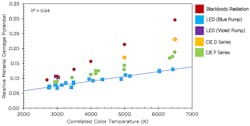In a new brief, the U.S. Department of Energy (DOE) has set out to clear up what it believes are misconceptions about LED lighting, in particular those that relate to the blue-light content of white-light LEDs.
The technical brief is entitled "True Colors: LEDs and the Relationship Between CCT, CRI, Optical Safety, Material Degradation, and Photobiological Stimulation." Note: The correlated color temperature (CCT) is the temperature of the blackbody radiator that has the same perceived color of the "warm" or "cool" white-light source (in this case the LED), while the color-rendering index (CRI) is a measure of how well the LED imitates an ideal white-light blackbody radiator, with the highest rating, a perfect imitation, being 100. High-quality LEDs can achieve a CRI greater than 90.
Dataset of 20 LED lighting products
"Using an example dataset of 20 CALiPER-tested LED lighting products that cover the full range of market-available CCTs and CRIs, it [the brief] separates myth from fact regarding the potential of LEDs to cause retinal damage, changes to artwork or other media, and stimulation of the human circadian system (which impacts health)," notes Jim Broderick of the DOE.
Broderick explains that too much exposure to "blue light" (radiant energy with wavelengths between about 400 and 480 nm) is known to cause retinal damage, and the spectral power distributions of LEDs feature a peak in the short-wavelength blue region (around 450 nm) as well as a broader peak somewhere between 550 and 650 nm. "But this doesn't mean LEDs are more likely than other sources to cause retinal, material, or circadian harm," says Broderick. "In fact, those risks are roughly the same for typical commercially available LEDs as for other source types with the same CCT—because they all generally contain equivalent amounts of blue light. In general, CCT can be used as a basic predictor of short-wavelength content across various source types, and specifically as a predictor of optical safety, material degradation, and circadian stimulation."
Type of light source doesn't matter for photobiological effects
The brief concludes: "The photobiological effects of light are related to the spectrum and intensity of light, but are not specific to any type of light source. Especially when nighttime exposure is a concern, choosing lower-CCT sources will generally reduce the photobiological risk potential. In critical applications, evaluations beyond CCT are warranted."
In other words, to achieve a lower photobiological effect, a "warmer" white-light source is warranted; however, whether that source is an LED, halogen, or compact fluorescent makes no difference, according to the brief.
The DOE brief covers all three topics of optical safety, photodegradation of materials, and photobiological stimulation (which is related to circadian rhythms). The brief can be found at www.ssl.energy.gov/tech_reports.html.

